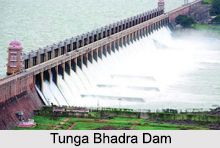 Tunga Bhadra Dam is situated in the state of Karnataka. The dam is constructed on the Tungabhadra River, which is the tributary of Krishna River. The Tungabhadra project is a joint venture of the states of Andhra Pradesh and Karnataka. The dam is 2441 meters in length and 49.38 meters in height. It is located across the River Tungabhadra at Mullapuram in the district of Bellary, at a distance of about 4.8 kilometers from Hospet. The Tunga Bhadra Dam is one of the biggest multipurpose dams of Karnataka state. The project also consists of three main canals, one on the left bank side and another two are on the right bank side. They are called the Left Bank Canal, the Low Level Canal and the High Level Canal. The Tunga Bhadra Dam is one of the multipurpose dams.
Tunga Bhadra Dam is situated in the state of Karnataka. The dam is constructed on the Tungabhadra River, which is the tributary of Krishna River. The Tungabhadra project is a joint venture of the states of Andhra Pradesh and Karnataka. The dam is 2441 meters in length and 49.38 meters in height. It is located across the River Tungabhadra at Mullapuram in the district of Bellary, at a distance of about 4.8 kilometers from Hospet. The Tunga Bhadra Dam is one of the biggest multipurpose dams of Karnataka state. The project also consists of three main canals, one on the left bank side and another two are on the right bank side. They are called the Left Bank Canal, the Low Level Canal and the High Level Canal. The Tunga Bhadra Dam is one of the multipurpose dams.
Structure of Tunga Bhadra Dam
Tunga Bhadra Dam`s chief architect was Dr. Thirumalai Iyengar. Since the dam was built as per his plans, a general purpose hall at this place was made in his honour. The storage capacity of the dam is 135 Tmcft. Due to siltation, the capacity of this dam is decreased to 30 Tmcft. In case of late and seasonal rains, 235 Tmcft water, reserved in the dam, is distributed.
Of the three canals included in the Tungabhadra project, the Left Bank Canal is 225 kilometers in length with a capacity of 7000 cusecs cubic feet per second. It has the potential to provide irrigation to about 3 lakh hectares of land in the Raichur and Bellary district in the state of Karnataka and Kurnool, Cuddapah and Anantpur district in the state of Andhra Pradesh.
The Low Level Canal is 349 kilometers in length. Originating from the right bank of the Tungabhadra River, this canal runs through the states of Andhra Pradesh and Karnataka. This project has irrigation potential for about 97,566 hectares of land in Karnataka and Andhra Pradesh. The Power Canal on the Right Bank side sustains the power house at Hampi.
The High Level Canal has a total length of 196 kilometers. Its capacity is 4999 cusecs at the head. This canal provides irrigational facilities to about 80900 hectares of land in Karnataka and 101900 hectares of land in Andhra Pradesh.
Powerhouses near Tunga Bhadra Dam
Apart from these, the Tungabhadra project has two powerhouses with a cumulative installed capacity of 72 MW. The power, generated here, is shared between the States of Andhra Pradesh and Karnataka. Moreover, NCL Energy Ltd, a Hyderabad-based company, has been selected to set up a mini hydel project of 8.25 MW on the Right Bank High Level Canal (RBHLC). The project cost is about 22.20 crores. The basin of the High Level Canal close to the Tunga Bhadra dam has been selected as the future location of the powerhouse and the powerhouse is anticipated to have three units each with a capacity of 2,750 KV. The plant is expected to produce a gross energy of 30 million KW hours per annum. The project will be exploiting the water released from the Tungabhadra dam reservoir into the RBHLC to generate power. The energy generated at the project will be supplied to Karnataka and Andhra Pradesh.
Functions of Tunga Bhadra Dam
The current functions involving in the Tungabhadra project include the regulation of supplies of water to the States of Karnataka and Andhra Pradesh and regulation of power from the two powerhouses on the right side in accordance with such rules as may be made in this behalf by the Board. The project also looks after the maintenance of the Tunga Bhadra dam and reservoir, common to both the states of Andhra Pradesh and Karnataka, which includes undertaking safety measures for the spillway and dams. The project facilitates fisheries in the reservoir and it also looks into the proper utilization of land acquired under the project. The Tungabhadra project also looks for new schemes for the generation of hydro electric power.
Tourism in Tunga Bhadra Dam
There is a small lighthouse, situated at the apex of the mount, beside the Tungabhadra dam. One of the most suitable places to have an astounding view of the surrounding is this light house. There is also a garden designed by the Karnataka Government. The site of this dam has also become a picnic or tourist destination over the years. This place is also visited for the reason that it is close to the world-renowned heritage site of Hampi. On the 15th of August, all the gates of this dam are opened.
Visiting Information to Tunga Bhadra Dam
August is the best time to visit the Tunga Bhadra dam. Nearest airport of this dam is Hubli Airport; nearest railway stations are Yalvigi and Savanur railway stations. This place is well connected to all major cities via bus routes and regular buses are available to reach the place.



















